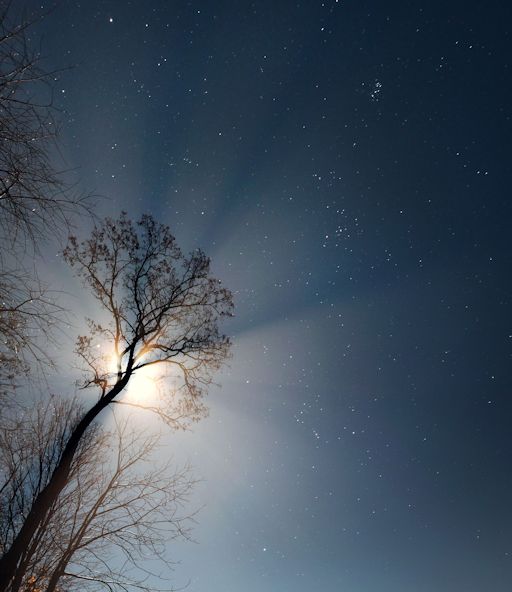COUNTDOWN TO PLUTO: NASA's New Horizons spacecraft is closing in on Pluto. Officials say the encounter begins less than a year from now. Although Pluto has been demoted from planethood by a small group of professional astronomers, it is still a sizable world, some 5000 miles around the equator with a system of moons and perhaps even rings. New Horizons is heading for one of the most exciting planetary flybys of the Space Age. Get the full story and a video from Science@NASA.
SMALLEST FULL MOON OF THE YEAR: Can you see the difference? Tonight's full Moon is the smallest full Moon of the year--an "apogee moon," as much as 14% smaller and 30% dimmer than other full Moons of 2014. Such a reduced full Moon still produces a lot of light, as shown in this photo taken on Apogee's Eve (Jan. 14) by Neil Winston of Lusby, Maryland:
"Fog rolled in as the temperature dropped after some rainfall," says Winston. "The bright moon cast distinct rays of light through gaps in the trees."
Full Moons vary in size and brightness because of the oval shape of the Moon's orbit. The Moon follows an elliptical path around Earth with one side ("apogee") about 50,000 km farther than the other ("perigee"). Big full Moons on the perigee side of the Moon's orbit are sometimes called "Supermoons." That would make tonight's full Moon an "anti-Supermoon"--or perhaps, "kryptonite."
Step outside after sunset and take a look. Backyard astronomy alerts: text, voice.

Solar wind
speed: 469.1 km/sec
density: 1.0 protons/cm3
explanation | more data
Updated: Today at 1537 UT
X-ray Solar Flares
6-hr max: B7 1453 UT Jan15
24-hr: B9 0712 UT Jan15
explanation | more data
Updated: Today at: 1500 UT
![]()
Daily Sun: 15 Jan 14
Departing sunspot AR1944 poses a waning threat for M-class solar flares, not Earth-directed. Credit: SDO/HMI
![]()
Sunspot number: 95
What is the sunspot number?
Updated 15 Jan 2014
Spotless Days
Current Stretch: 0 days
2014 total: 0 days (0%)
2013 total: 0 days (0%)
2012 total: 0 days (0%)
2011 total: 2 days (<1%)
2010 total: 51 days (14%)
2009 total: 260 days (71%)
Update 15 Jan 2014
The Radio Sun
10.7 cm flux: 137 sfu
explanation | more data
Updated 15 Jan 2014
![]()
Current Auroral Oval:
Switch to: Europe, USA, New Zealand, Antarctica
Credit: NOAA/POES
![]()
Planetary K-index
Now: Kp= 0 quiet
24-hr max: Kp= 3 quiet
explanation | more data
Interplanetary Mag. Field
Btotal: 2.5 nT
Bz: 0.3 nT north
explanation | more data
Updated: Today at 1329 UT
![]()
Coronal Holes: 15 Jan 14
There are no large coronal holes on the Earthside of the sun. Credit: SDO/AIA.





